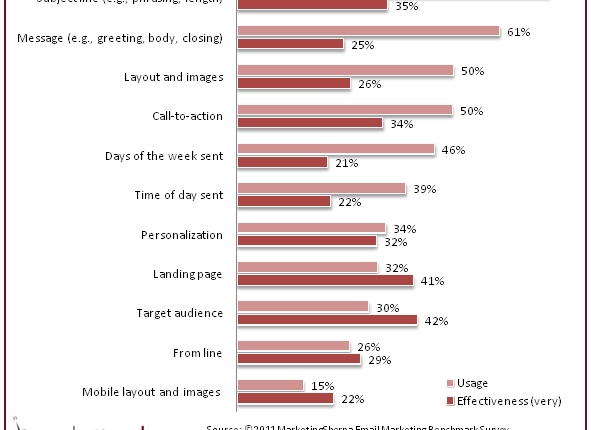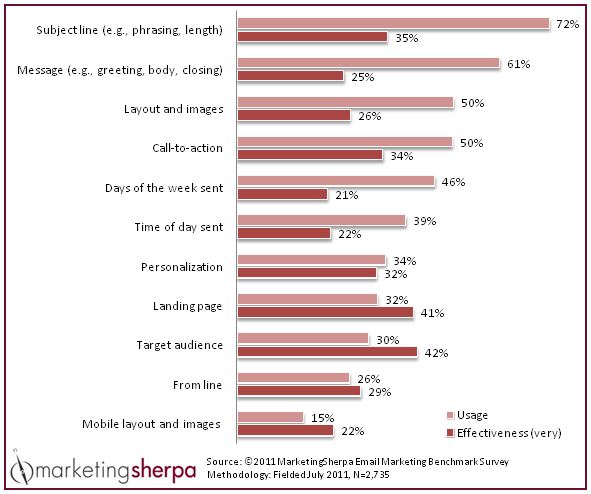Email Marketing: Questions about subject line length, differentiating alert emails, and multivariate testing
In the MECLABS editorial content department, our goal is to help you do your job better. One way we can do that is by answering your questions. And for tomorrow’s MarketingSherpa webinar (sponsored by ReturnPath) – “Email Marketing: 3 Tips for Producing Engaging Email Content” – we have received a plethora of questions.
While Courtney Eckerle, Reporter, MECLABS, and I will try to answer as many of your questions as possible in the hour-long webinar, I wanted to answer a few testing-related questions in today’s MarketingExperiments blog post, as well …
Looking for tips on appropriate subject line and message length – my emails all tend to be too LONG! We’re in B2B sending emails to HR professionals.
My biggest question back to you is … how do you know they’re too long? Essentially, how do you know they are not the optimal length?
I would suggest testing subject line and message length with your audience. The results might surprise you.
For example, we found in an email test to a B2B audience where the longer subject line actually generated 8.2% more opens than the shorter subject line.
With email subscriptions that are really for new product alerts by topic, how should we differentiate subject lines and content, and how much should be kept the same for continuity?
A major challenge an email marketer in your situation would have is mindlessly relying on too much assumed value. In other words, your audience signed up for an email subscription on a specific topic (in this case, new product alerts), so simply sending them a rote email every time with those product alerts will be exactly what they’re looking for. So first of all, kudos to you for thinking through what will be most valuable for your subscribers.
I think you’ll find that there will be an inflection point with each subscriber. That is, at some point, the topic of the specific email (for example, an alert on a new LED light bulb) will become less important than the brand of your series of emails itself (for example, green product alerts) since they’ve come to rely on your brand.
I think the best way to approach this is to test the specific topics versus your email list brand. For example, we’re currently testing email invitations for MarketingExperiments Web clinics to see what is of more value to our audience – simply that a new Web clinic is coming up, or the specific topic of the upcoming Web clinic.
Of course, we’ll discuss both elements of value in every email at some level; the real question is which element to emphasize.
A simple way to start testing is with a subject line test where you decide with which value to lead. For example …
- Subject Line A: Today: Web clinic invite – Holiday Shopping Cart Optimization
- Subject Line B: Today: Holiday Shopping Cart Optimization – Web clinic invite
Again, we’re showcasing both elements of value, but much like a journalist, this can help you determine what to lead with, or where and how you should change the elements of value you communicate in your emails.
How do you usually do multivariate testing? Do you just variate one factor or test more than one variable at the same time? If only testing one variable, which one is the most affected factor to test?
That’s really two questions (hey, a multivariate question!), so let me touch on each.
First, multivariate testing. By your question, I’m assuming that you don’t have a fancy-schmancy tool to do this for you. It sounds like you’re simply trying to test more than one variable at a time in your email marketing.
This can be a little tricky. After all, the benefit of testing is to get a definitive answer. If you simply change the headline, you will know that the headline is what caused the difference in results. However, if you change the headline and an image, or even more factors, how do you know which result to attribute the change to?
Instead, you want to create treatments based on a specific hypothesis. For example, if you’re selling a car, and you’re trying to determine which value most resonates with a specific segment of your list, here is how you could test …
- Fuel efficient – Subject line that mentions miles per gallon, headline that says how far you can go on a tank of gas, image of an EPA mpg estimates, and copy about an engineer discussing the latest hybrid advances
- Safety – Subject line mentions chance of getting in car accidents, headline that touts crash test rankings, image of airbags in car, and testimonial from family saved by car’s safety technology
Then, you can conduct follow-up testing to determine which expressions of these elements of value resonate best with this segment. For example, if fuel efficiency wins, are people more interested in miles per gallon or money saved at the pump? This could be a single variable email test where you focus on subject line.
Now to the second part of your question, here is data from the MarketingSherpa 2012 Email Marketing Benchmark Report about the most effective elements to test …
Are there any recent test results comparing the results of plain text, graphics-free emails vs. HTML emails?
Do plain text or HTML emails work better? Yes.
What I mean by that is, the results are highly variable to different segments and products. For example, for a B2B email about a complex technology product, a plain text email might work better. But for a beach resort, images will likely help.
With that caveat aside, in direct response to your question, here is a test where the graphic email generated a 75% higher clickthrough rate than the plain text email.
Email subject line is a good one.
It certainly is. Here is a great email subject line test that you might find helpful as you craft your own … “Case Study: Creativity vs. clarity in email subject lines”
Related Resources:
Email Testing: More specific subject line improves open rate by more than 35%
Email Messaging Test: 104% increase in conversion from rented list
Email Optimization: How to prioritize your A/B testing
Email Copy Tested: How adding urgency increased clickthrough by 15%





Personally I love to see people test any one of these categories because it shows that they realize their email marketing efforts can be improved. In many cases, it seems people do email marketing because they have been told to do it and don’t really expect much in return. In reality, even simple changes can make huge differences in a company’s bottom line.
The subject header does seem to be a favorite one to test (and it helps that it is easy to think of another test subject line). I like to recommend this one first for the obvious reason that it is an easy win. If they aren’t used to testing a ton of different items, this is an easy one that can result in big changes.
Seeing segmentation lead the pack in effectiveness is also no surprise. Imagine the difference in sending an email about a basketball jersey to a person who has purchased one before. All too often, even this basic level of segmentation is overlooked by retailers.